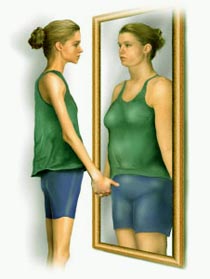Why people prefer to starve, driving themselves almost to exhaustion, or eat so little that soon come on the verge of illness? Serious consequences of physical and mental well-being of anorexia and bulimia have brought to life a number of theories. It is not possible to allocate any single factor as the principal cause of anorexia and bulimia. More than that, such search is complicated by the hen-and-egg causality problem. Are disorders of patterns of nutrition are caused by neurobiological processes or it is eating disorders that cause changes of neurobiology?
In order to explain the gradual degenerative process of development of this or that eating disorder, it is necessary to recognize all three basic etiological constituents: biological, sociocultural (including family and peers) and psychological. They may act alone or together, causing derangements of person's self-control.
We shall start with the biological constituent. Practically there are no objections, that neurobiological factors play rather an insignificant role in occurrence of anorexia and bulimia. However such factors can maintain these disorders, as they influence on appetite, mood, perception and energy regulation.
It is logical to assume, that biological mechanisms (genes, neurochemical processes), acting together or apart bear responsibility for derangements of regulatory functions. A person with an insignificant deviation undermines normal regulatory processes by unreasoned attempts to reach purposes connected with weight or dieting. In its turn it can cause universal changes in central nervous and neuroendocrine systems, which, in their turn, can cause new derangements and so on. Thus, it is also logical to admit, that ability to control such important reactions of the organism as hunger and appetite can result in unnatural habits in nutrition, which can result in unhealthy patterns of food consumption.
In order to explain the gradual degenerative process of development of this or that eating disorder, it is necessary to recognize all three basic etiological constituents: biological, sociocultural (including family and peers) and psychological. They may act alone or together, causing derangements of person's self-control.
We shall start with the biological constituent. Practically there are no objections, that neurobiological factors play rather an insignificant role in occurrence of anorexia and bulimia. However such factors can maintain these disorders, as they influence on appetite, mood, perception and energy regulation.
It is logical to assume, that biological mechanisms (genes, neurochemical processes), acting together or apart bear responsibility for derangements of regulatory functions. A person with an insignificant deviation undermines normal regulatory processes by unreasoned attempts to reach purposes connected with weight or dieting. In its turn it can cause universal changes in central nervous and neuroendocrine systems, which, in their turn, can cause new derangements and so on. Thus, it is also logical to admit, that ability to control such important reactions of the organism as hunger and appetite can result in unnatural habits in nutrition, which can result in unhealthy patterns of food consumption.
